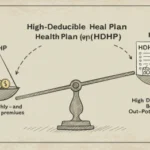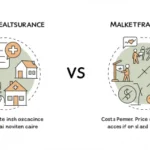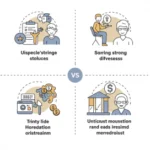Introduction: Why Health Insurance Isn’t Just About Premiums
When people think of health insurance costs, most focus on the monthly premium. But premiums are just the beginning. The reality is, health insurance includes a range of hidden costs—some predictable, others surprising—that can add up quickly.
In this article, we’ll unpack all the hidden costs you might face with your health insurance policy. Whether you’re choosing a new plan or trying to make sense of your current one, knowing these details can help you avoid unexpected bills and make smarter financial decisions.
Stay up to date on insurance insights here:
https://healthmanual.net/insurance-news/
1. Deductibles: The Paywall Before Your Insurance Kicks In
A deductible is the amount you pay out-of-pocket before your insurance begins to cover services.
- If your plan has a $2,000 deductible, you’ll pay for the first $2,000 of medical expenses yourself.
- Some plans offer low premiums but high deductibles, which means you pay less monthly but more when you need care.
Hidden cost? If you don’t budget for your deductible, even a routine surgery can result in a big financial surprise.

2. Copayments: The Small Charges That Add Up
A copayment (copay) is a fixed amount you pay for services like doctor visits, urgent care, or prescriptions.
- Common copays: $25 for a primary care visit, $50 for a specialist.
- Emergency room copays can be $150 or more—even with insurance.
Hidden cost? Frequent visits can turn small fees into hundreds per month, especially if you’re managing a chronic condition.
3. Coinsurance: When You Share the Bill With Your Insurer
Coinsurance is a percentage of the cost you must pay after meeting your deductible.
- Example: If your plan has 20% coinsurance, and you get a $1,000 procedure, you’ll pay $200 even after the deductible.
Hidden cost? High-cost treatments or tests like MRIs, surgeries, and hospital stays can lead to significant bills even after insurance starts covering part of the cost.
4. Out-of-Network Charges: The Silent Killer
Going to a doctor or hospital outside your plan’s network can drastically increase costs.
- Some plans don’t cover out-of-network care at all.
- Even if they do, you’ll likely pay more—sometimes double or triple.
Hidden cost? In an emergency or by mistake, going out-of-network could leave you with thousands in bills.
5. Prescription Drug Costs
Not all medications are fully covered, and plans usually have formulary tiers:
- Tier 1: Generic drugs (lowest cost)
- Tier 2: Preferred brand-name drugs
- Tier 3–4: Specialty drugs (highest cost)
Hidden cost? Specialty medications can cost hundreds to thousands of dollars, even with insurance.
Tip: Always check if your medication is covered and which tier it falls under.
6. Non-Covered Services
Even with insurance, some services may not be covered at all:
- Cosmetic surgery
- Some alternative therapies (like acupuncture)
- Experimental treatments
- Certain mental health services
Hidden cost? If you assume everything is covered and it’s not, you could face full-price bills with no reimbursement.
7. Prior Authorization Delays and Denials
Many plans require prior authorization before they’ll cover certain procedures or prescriptions.
- Without it, your claim can be denied.
- This process can take time, delaying treatment.
Hidden cost? Delays in care can lead to worsening health conditions or having to pay upfront to get immediate treatment.
8. Surprise Medical Billing
Even if you’re at an in-network hospital, an out-of-network anesthesiologist or radiologist may be involved.
- This creates surprise medical bills that you didn’t expect.
- Some protections exist under U.S. law, but loopholes remain.
Hidden cost? One surprise provider can create a four-digit bill, even if you did everything “right.”
9. Mental Health Coverage Limits
Mental health care is required to be covered under most plans, but the scope of that coverage varies.
- Limited therapist networks
- Cap on the number of sessions
- Higher cost-sharing
Hidden cost? Accessing consistent and affordable mental health care can be difficult, especially if the provider is out-of-network.
10. Time and Complexity: The Emotional Cost
Understanding your health insurance plan often requires:
- Reading dense policy documents
- Calling customer service multiple times
- Managing claims and appeals
Hidden cost? The time, stress, and confusion involved can become an emotional and logistical burden.

How to Minimize Hidden Costs
Here are a few ways to reduce or prepare for hidden costs:
- Understand your plan’s full Summary of Benefits and Coverage (SBC).
- Use in-network providers whenever possible.
- Ask for cost estimates before receiving services.
- Utilize free preventive services covered under ACA.
- Shop around for prescriptions at different pharmacies.
- Consider an HSA (Health Savings Account) if you have a high-deductible plan.
Conclusion: Be Proactive, Not Reactive
Health insurance is essential—but understanding what you’re really paying for is even more important. While premiums may seem like the only cost, hidden fees and exclusions can affect your financial health as much as your physical health.
By educating yourself and reviewing your plan carefully, you can avoid surprises and make more informed choices.
For more health insurance articles and cost breakdowns, visit:
https://healthmanual.net/insurance-news/

Hi, I’m Hibiki — the writer behind HealthManual.net.
I cover health insurance news, wellness tips, and insightful analysis of pharmaceutical and healthcare stocks. My goal is to simplify complex topics and make health and finance information more accessible to everyone.
Thanks for reading — I hope you find the content helpful and reliable.















